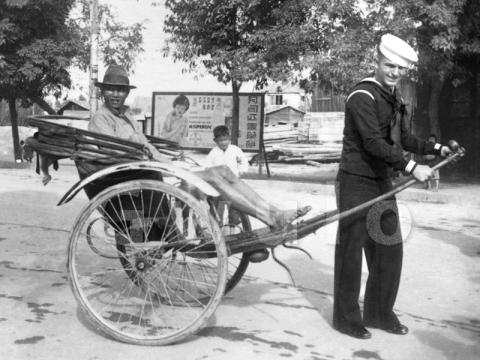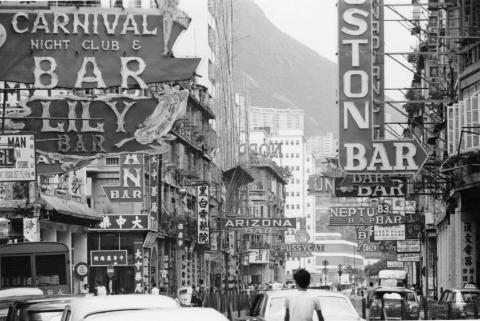An American sailor has swapped places with the rickshaw puller in this photo from 1929. The sailor was serving on the USS Tulsa, an American gunboat that had previously been stationed off Central America. The Tulsa joined the Asiatic Fleet in early 1929, so this was probably one of the sailor’s first visits to Hong Kong. He’s wearing a white ‘dixie cup’ hat, not the darker ‘flat hat’ we saw earlier in the Happy Valley Grandstand photo.
The American community in Hong Kong is the last one large enough to get its own segment on the 1931 pie chart, with 494 members. Well, 494 give or take a few hundred. The exact number is up for debate, and part of the confusion is due to that Asiatic Fleet.
The census count included everyone on the ships in the Victoria harbour on census day. The odd passenger or two doesn’t make a big difference, but on 7 March 1931 an American naval transport was visiting with 133 men and 37 women on board – subtract them, and the size of the American community drops significantly, to 324.
The bigger issue is that the table I used for the pie chart is based on race. If we switch to a different census table that recorded people by nationality, we get a total of 1,326 Americans. The largest addition is the 446 people who reported Chinese race but American nationality.
Those 446 people likely traced their American nationality back to the wave of Chinese immigration in the mid-19th century, as in 1882 the USA introduced the Chinese Exclusion Act to block further Chinese immigration. Australia followed in 1901 with its White Australia policy, then Canada in 1923 with its revised Chinese Immigration Act. Race and nationality were hot topics at the time, so it’s not surprising they receive so much attention in the 1931 census.
Our sailor would have spent the 1930s on the Tulsa calling at ports along the coast of China, sailing inland along the Yangtze River, and occasionally visiting the Philippines, where the Asiatic Fleet was based. The Tulsa was in the Philippines in December 1941, but managed to evade the Japanese attacks to reach the Dutch East Indies, and then Australia. She survived the war.
The Americans caught up in the war here in Hong Kong were also able to make a lucky escape. Japan was willing to give them their freedom in exchange for the release of Japanese internees who were being held in camps in the USA. So although the Americans were interned in Stanley Camp in January 1942, at the end of June they were released to board the Asama Maru, which carried them to Mozambique. There a carefully-choreographed exchange took place as the Japanese and Americans swapped ships. The Americans boarded the Gripsholm and, almost two months after leaving Stanley, arrived safely in New York.
Later wars would see American servicemen escaping to Hong Kong. During the Vietnam War in the 1960s and 70s, many of those servicemen chose to visit Hong Kong for their R&R (rest and recuperation). Business boomed for Hong Kong’s tailors and camera shops, and especially for Wanchai’s bars.
The above photos and text are the final extract from my new book, Volume 5 of the Old Hong Kong Photos and The Tales They Tell series.
| You can pre-order Volume 5 to get special pricing, free shipping, and signed copies. Click here for details. Offer ends 22 Dec. |
This book has taken longer than expected, as it has lots of photos that I hadn't used before. If I've previously used a photo in a newsletter, say, then most of the clean-up work has been done already, but that isn't the case with many of the photos in Volume 5. So it has been nonstop Photoshop for me over recent weeks, but I'm happy to say I sent the last batch of edits over to the designer last night. Once I've checked the updated layout it can go off to the printer for them to output the digital proofs. After reviewing the proofs there are usually tweaks to one or two photos, then printing can begin. We're nearly there!
Volumes 1-4 of the book series are available to order from the Gwulo website, in local bookstores, and from Amazon (affiliate link).
Further reading on Gwulo
- More extracts from Volume 5:
- Related pages:
- Photos of the US Navy in Hong Kong
- Photos of rickshaws
- Diary entries from the 1942 repatriation of Americans from Stanley Camp
- Some of Wanchai's bars in the 1960s:
1965 Lockhart Road Bar Signs, by moddsey
- Photos of the US Navy in Hong Kong

